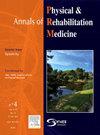膝骨关节炎患者股四头肌超声评估:一项系统回顾和荟萃分析
IF 4.6
3区 医学
Q1 REHABILITATION
Annals of Physical and Rehabilitation Medicine
Pub Date : 2025-07-08
DOI:10.1016/j.rehab.2025.101998
引用次数: 0
摘要
膝关节骨性关节炎(OA)是一种疼痛的关节疾病,其特征是股四头肌结构和质量的改变。尽管超声是评估这一人群肌肉状况的新兴工具,但其实用性和临床意义尚不清楚。目的探讨膝关节骨性关节炎对股四头肌结构的影响,总结研究中使用的超声方案,探讨肌肉特征与症状和身体功能之间的关系。材料和方法由2名独立研究者根据严格的纳入和排除标准对3个电子数据库(PubMed、PEDro和EMBASE)进行检索。结果:尽管人们对膝关节骨性关节炎患者股四头肌的变化,特别是肌肉厚度和回声强度的变化越来越感兴趣,但研究结果强调,超声检查方案往往缺乏详细的描述。荟萃分析显示,与健康对照组相比,膝关节OA患者的股内侧肌厚度显著降低(平均差异:0.52 mm;95% CI -1.01 ~ -0.03;P = 0.037),而股直肌、股外侧肌和股中间肌厚度无显著差异。在定性综合中,系统的文献分析显示肌肉变化,包括股内侧肌和股中间肌的肌肉质量下降。此外,股四头肌厚度与膝关节OA患者的病情特异性、患者报告的结果和功能表现有关,而回声强度与功能表现之间存在关系。结论:该研究强调需要标准化的超声方案来捕获股四头肌结构和质量的变化,因为这些变化与患者报告的结果测量和膝关节OA患者的功能表现相关。最后,我们提出了在临床实践中改进肌肉回声强度测量的建议。试验注册prospero数据库(注册号:CRD42023471617)。本文章由计算机程序翻译,如有差异,请以英文原文为准。
Ultrasonographic assessment of quadriceps muscle in people with knee osteoarthritis: A systematic review and meta-analysis
Background
Knee osteoarthritis (OA) is a painful joint condition characterized by changes in quadriceps femoris muscle architecture and quality. Although ultrasound is an emerging tool for evaluating muscle conditions in this population, its usefulness and clinical implications remain unclear.
Objectives
To investigate the effects of knee OA on quadriceps muscle architecture, summarize ultrasound protocols used in studies, and explore the associations between muscle characteristics with symptoms and physical function.
Materials and methods
Searches across 3 electronic databases (PubMed, PEDro, and EMBASE) were performed by 2 independent investigators according to strict inclusion and exclusion criteria.
Results
The findings highlight that ultrasound protocols often lack detailed descriptions, even if there is growing interest in how the quadriceps femoris muscle changes in knee osteoarthritis people, particularly in muscle thickness and echo intensity. The meta-analysis revealed that vastus medialis muscle thickness was significantly lower in individuals with knee OA compared to healthy controls (mean difference:0.52 mm; 95 % CI -1.01 to -0.03; P = 0.037), whereas no significant differences were found for rectus femoris, vastus lateralis, or vastus intermedius thickness. In the qualitative synthesis, the systematic literature analysis showed muscle changes, including a decreased muscle quality in both the vastus medialis and vastus intermedius. Additionally, quadriceps femoris muscle thickness is associated with condition-specific, patient-reported outcomes and functional performance in people with knee OA, whereas there is a relationship between echo intensity and functional performance.
Conclusions
The study highlights the need for standardized ultrasound protocols to capture changes in quadriceps muscle architecture and quality, as some of these changes correlated to patient-reported outcomes measures and functional performance in knee OA people. Finally, we propose a recommendation to improve the measurement of muscle echo intensity in clinical practice.
Trial registration
PROSPERO database (registration number: CRD42023471617).
求助全文
通过发布文献求助,成功后即可免费获取论文全文。
去求助
来源期刊

Annals of Physical and Rehabilitation Medicine
Medicine-Rehabilitation
CiteScore
7.80
自引率
4.30%
发文量
136
审稿时长
34 days
期刊介绍:
Annals of Physical and Rehabilitation Medicine covers all areas of Rehabilitation and Physical Medicine; such as: methods of evaluation of motor, sensory, cognitive and visceral impairments; acute and chronic musculoskeletal disorders and pain; disabilities in adult and children ; processes of rehabilitation in orthopaedic, rhumatological, neurological, cardiovascular, pulmonary and urological diseases.
 求助内容:
求助内容: 应助结果提醒方式:
应助结果提醒方式:


